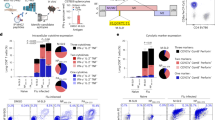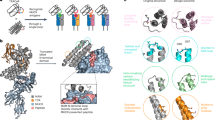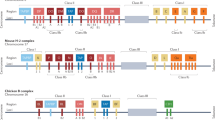Abstract
Activation of T lymphocytes requires the intracellular fragmentation of foreign antigens and their presentation by class I or class II major histocompatibility complex (MHC) glycoproteins1–2. The direct binding of peptides to class II molecules has been demonstrated using equilibrium dialysis, gel filtration and fluorescence energy transfer at planar membranes, and its specificity compared to that of T-cell activation3–6. In contrast, direct binding of peptides to class I molecules has been difficult to detect; although peptide sensitization experiments7–8. and the crystallographic structure of HLA-A2 (ref. 9) persuasively argue for its occurrence and importance. Here we describe a gel filtration assay from which we derive direct evidence for selective binding of an influenza matrix peptide to HLA-A2 and for binding of an influenza nucleoprotein peptide to HLA-B37. These two peptides have previously been shown to act respectively as targets for certain HLA-A2 or HLA-B37 restricted influenza-specific cytotoxic T lymphocytes (CTL) 7,8,10. In addition we demonstrate binding to some, but not all, HLA allospecificities that cannot present these peptides to CTL. We estimate that less than 0.3% of the HLA molecules present in any given purified preparation were able to bind the added peptides.
This is a preview of subscription content, access via your institution
Access options
Subscribe to this journal
Receive 51 print issues and online access
$199.00 per year
only $3.90 per issue
Buy this article
- Purchase on SpringerLink
- Instant access to full article PDF
Prices may be subject to local taxes which are calculated during checkout
Similar content being viewed by others
References
Townsend, A. R. M. Immunol. Res. 6, 80–100 (1987).
Unanue, E. R., Beller, D. I., Lu, C. Y. & Allen, P. M. J. Immun. 132, 1–5 (1984).
Babbitt, B. P., Allen, P. M., Matsueda, G., Haber, E. & Unanue, E. R. Nature 317, 359–361 (1985).
Buus, S., Sette, A., Colon, S., Miles, C. & Grey, H. M. Science 235, 1353–1358 (1987).
Guillet, J. G., Lai, M. Z., Briner, T. J., Smith, J. A. & Gefter, M. L. Nature 324, 260–262 (1986).
Watts, T. H., Gaub, H. E. & McConnell, H. M. Nature 320, 179–181 (1986).
Gotch, F., Rothbard, J., Howland, K., Townsend, A. & McMichael, A. Nature 326, 881–882 (1987).
Townsend, A. R. M., et al. Cell 44, 959–968 (1986).
Bjorkman, P. J. et al. Nature 329, 506–512 (1987).
Gotch, F., McMichael, A., Smith, G. & Moss, B. J. exp. Med. 165, 408–416 (1987).
Bodmer, H. C., Gotch, F. M. & McMichael, A. J. Nature 337, 653–655 (1989).
Buss, S., Sette, A., Colon, S., Jenis, D. M. & Grey, H. M. Cell 47, 1071–1077 (1986).
Müller, C., Ziegler, A., Müller, G., Schunter, F. & Wernet, P. Human Immun. 5, 269–281 (1982).
Sheppard, R. C. & Williams, B. J. Int. J. Peptide Protein Res. 20, 451–454 (1982).
Parham, P. Meth. Enzym. 92, 110–138 (1982).
Russo, C, Ng, A. K., Pellegrino, M. A. & Ferrone, S. lmmunogenetics 18, 23–35 (1983).
Bamstable, C. J. et al. Cell 14, 9–20 (1978).
Brodsky, F. M. & Parham, P. J. Immun. 128, 129–135 (1982).
Parham, P. J. Immun. 131, 2895–2902 (1983).
Author information
Authors and Affiliations
Rights and permissions
About this article
Cite this article
Chen, B., Parham, P. Direct binding of influenza peptides to class I HLA molecules. Nature 337, 743–745 (1989). https://doi.org/10.1038/337743a0
Received:
Accepted:
Issue Date:
DOI: https://doi.org/10.1038/337743a0



